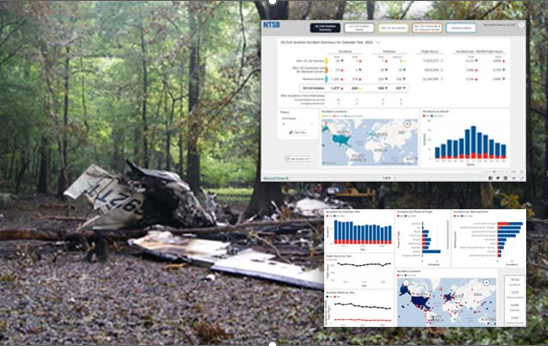FAA and NTSB reinforce the VALUE of aviation safety data!!!

Two prominent announcements emphasized DATA as the most critical element towards improving AVIATION SAFETY.
FIRST, FAA ADMINISTRATOR MIKE WHITAKER called Airlines CEOs to remind them the value of ASIAS, SMS, FOQA, SAS, VDRP, ASRS, ATSAP, among others. The value of data-sharing has been validated by independent experts and the published records worldwide confirm that BY USING PREDICTIVE ANALYSES, global aviation systems have transitioned from REACTIVE to PROACTIVE. The Administrator’s audience has the resources to collect, send and respond to these safety systems. Indeed, SMS is designed for individuation of safety programs for each air carrier. Prioritizing the company’s list of designed remedial actions should reinforce its SAFETY CULTURE.
SECOND, NTSB Chief Data Scientist LOREN GROFF, mindful of both GA’s NEED for added safety data and of these pilots’ more limited computer capacity/skills, created a “Yes, And” aviation safety dashboard designed for ease of use by this segment of aviation. Simply this flexible tool simplifies these pilots’ search for relevant data:
This interactive dashboard provides statistics and information about aviation accidents, utilizing data from the NTSB’s static accident spreadsheets in Excel. Unlike traditional spreadsheets, which offer limited information and control, this dashboard empowers users by bringing the data directly to them. Here are some key features:
- Enhanced Control: The dashboard allows users to explore data from different angles, including state/region, phase of flight, defining event, purpose of flight, aircraft category, and engine type.
- Comparison: Users can compare data across various aviation sectors, such as Part 121 air carriers, Part 135 commuter and on-demand carriers, general aviation, and U.S. civil aviation.
- Mapping Accidents: The dashboard lets users view a list of accidents linked to detailed accident reports and plot these incidents on a map.
- GA Focus: General aviation (GA) pilots can explore findings and recommendations issued by the NTSB for accidents that match their filters.
- Monthly Breakdown: Additionally, there’s a state-by-state, monthly breakdown of accidents, including a focus on Alaska due to congressional reporting requirements.
One of the myths about SMS and the related safety systems is that they are burdensome to administer. That view of this powerful tool comes from folks who have cut-and-paste some paragraphs from an SMS handbook. The introduction of SMS in any organization is not achieved merely by writing a bunch of words.
The first step is involvement in the process of designing your program by a representative team drawn from all aspects of the company. A facilitator, with prior experience in establishing this risk management regimen, will lead them through the steps, avoiding traps that waste time. The number one product from these sessions is the establishment of a SAFETY CULTURE by inculcating the participants in the imperative to be aware of risks, to consciously prioritize items isolated, to carefully design proactive solutions and to share their awareness throughout their peers.
These steps can be sized to the mission, geographical situation, and fleet. What justifies the time is the reduction of risks.

—————————————
Read Out from FAA Administrator Mike Whitaker’s Meeting with Airlines
Wednesday, February 7, 2024

FAA ADMINISTRATOR MIKE WHITAKER convened a meeting with airline CEOs today to discuss the current state of the U.S. aviation system and find ways to continuously improve safety. He also provided an update on the agency’s enhanced oversight activities of Boeing and its suppliers.
Administrator Whitaker called the meeting to ensure the aviation industry continues expanding safety management systems and finding ways to SHARE INFORMATION TRANSPARENTLY TO MINIMIZE RISK AND ADVANCE SAFETY.
“As I mentioned in my testimony yesterday, DATA is crucial to identifying and mitigating significant risks and emerging safety trends, allowing us to move toward a MORE PREDICTIVE SYSTEM,” said Administrator Whitaker. “Today we discussed the need for more access to real time data and better tools to detect and manage risk within our aviation system.”
“Aviation safety is a team sport, and it requires that we constantly reexamine processes and procedures as well as how we use data to detect risks and introduce more transparency in our business practices. I appreciate these aviation leaders joining me to discuss these important issues.”
“Maintaining safety and public confidence in the aviation system is not static; it is a relentless pursuit that requires constant improvement.”
Airlines that participated were from Alaska, American, Delta, United, JetBlue, Southwest, UPS and FedEx.
NTSB takes ‘Yes, And’ approach with new accident data dashboards
The NTSB is taking a “Yes, And” approach to its new U.S. Civil Aviation Accident

The NTSB is taking a “Yes, And” approach to its new U.S. CIVIL AVIATION ACCIDENT DASHBOARD. Find statistics in an interactive format, utilizing the same data from the NTSB’s static accident spreadsheets in Excel and adding more information and control with the data dashboard. The new dashboard gives the power to the user. Rather than the traditional Excel spreadsheets, which give users less information and less control, the dashboard brings the information directly to you. Users can grab data regularly to populate legacy products and allow the information to be seen from different points of view. The team kept the customer experience in mind when building the dashboard, keeping what they call a “Yes, And” approach. “We took a ‘Yes And . . .’ approach with all of the dashboards,” Chief Data Scientist Loren Groff said. “We’ll give you that familiar government document and we’ll also give you the new dashboard version with so much more control by the user.”

The NTSB has always provided an annual census first as a printed boot, then with updated Excel spreadsheets. Now, there will be an additional dashboard. There will be GA data available in the new format, debuting alongside an instructional video. “We rolled out the GA dashboard for Oshkosh (EAA Airventure),” Senior Aviation Accident Analyst Nathan Doble said. “We recognized that this is a new capability for many of our users, so we wanted to provide training and solicit their feedback.” The dashboard allows you to check data by various factors, including state/region, phase of flight, defining event, purpose of flight, aircraft category and engine type. Compare Part 121 air carriers, Part 135 commuter and on-demand carriers, general aviation and U.S. civil aviation. Bring up a list of accidents that link to accident reports and plot these on a map. GA pilots can discover findings and recommendations the NTSB issued in connection with the accidents that met the users’ filters. Groff, Doble and the NTSB data analytics team are taking accident data from static tables and using them in the interactive dashboard and offering increased content and capabilities for the user. Check out the NTSB U.S. Civil Aviation Accident Dashboard “Then there is the state-by-state, monthly breakdown,” Groff said. “We had a congressional requirement to report accidents in Alaska monthly. The NTSB data analytics team thought, if we’re doing it for Alaska, why not do it for all the states?” ©2024 GlobalAir.com, Haley Davoren. All rights reserved.